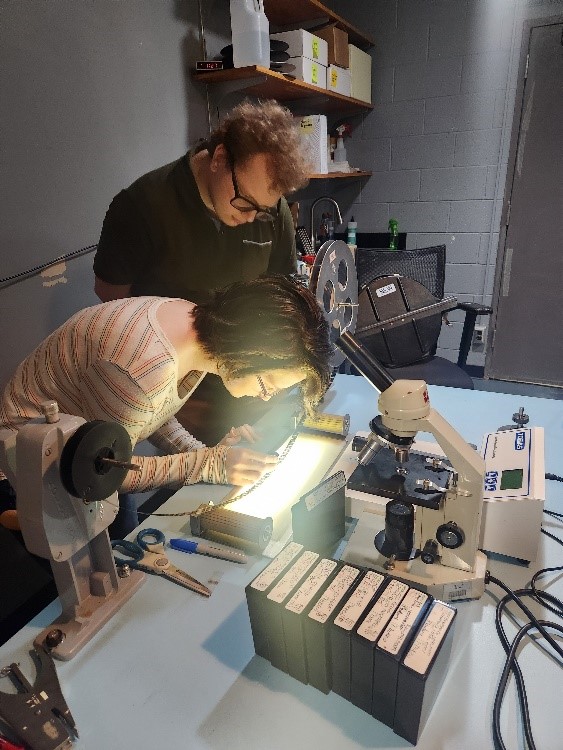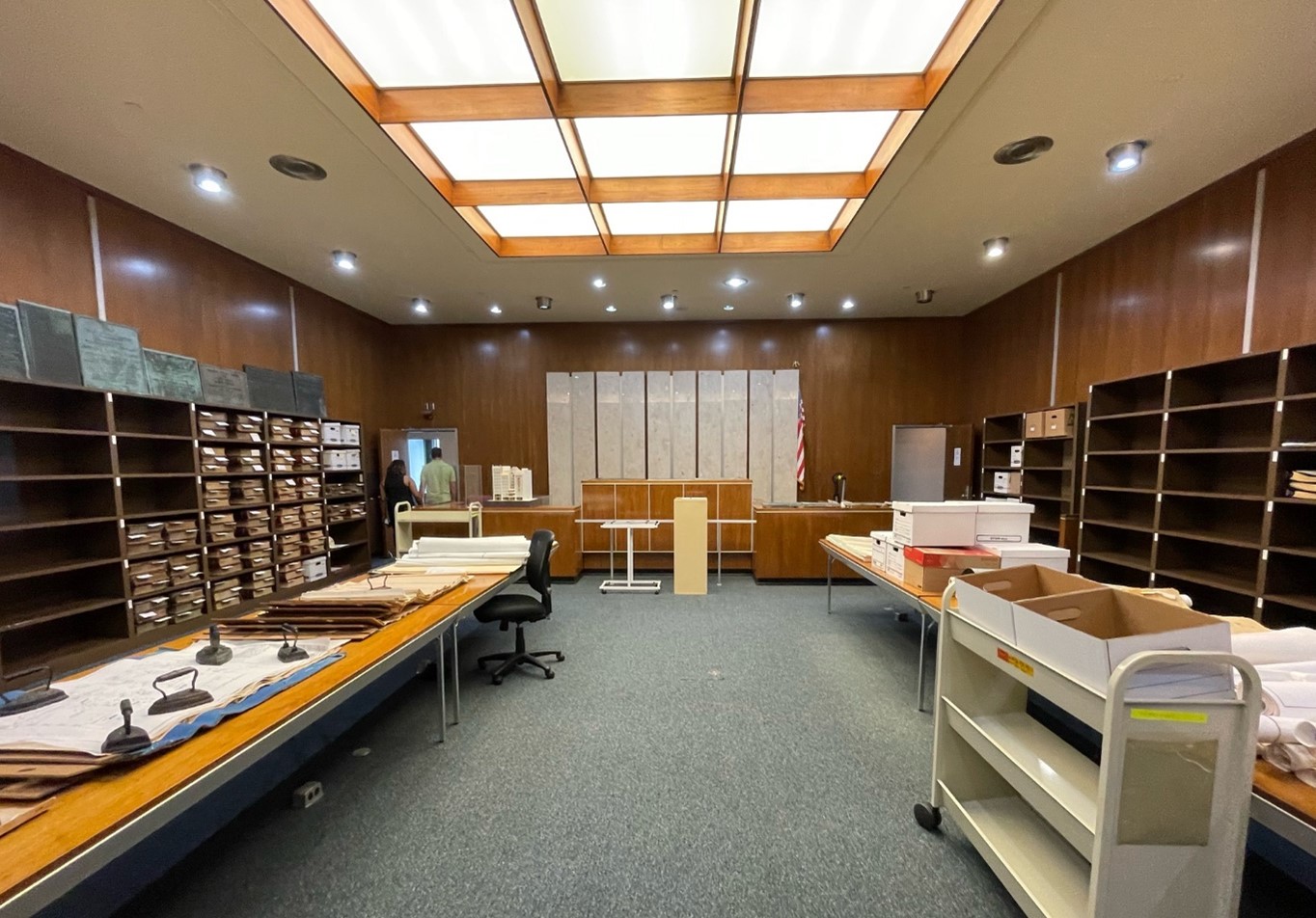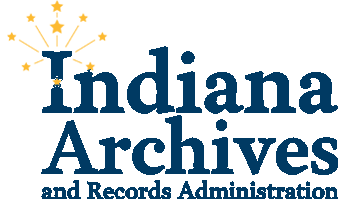Summer Interns 2024: Rae Stearman and James Moeller

IARA Summer Interns Rae Stearman and James Moeller examining some microfilm at the State Imaging and Micrographics Laboratory
Tales from the Interns: Rae
Hello, I’m Rae Stearman and I’m an incoming sophomore at the University of Indianapolis currently studying to get my bachelor’s in history, with an ambition of going into archival work. I am a Governor’s Summer Intern for 2024, and this is my first internship and experience in public history.
I’ve wanted to be an archivist ever since I found out it was a job, but Google descriptions of the profession are very vague. So, with this internship I was determined to get to the bottom of what so much historical research relies on. I learned that the role of an archivist differs depending on the institution, and at Indiana State Archives there are two separate archivist roles. A reference archivist is someone who works with the public to help answer their research questions. On the other hand, a processing archivist will organize, describe, and appraise records. Additionally, processing archivists work closely with the conservation lab to ensure that records will be around for years to come.
I also learned how processing works. Processing is the process of taking records (either backlog records already in the collection or incoming records from state agencies) and working to arrange, describe, and preserve them. Damaged records are given to conservation for cleaning and stabilization. There are often staples, binder clips, and paper clips that need to be removed so rust doesn’t corrupt a document. Acid-free paper is placed in between acidic paper to prevent the deterioration of surrounding records. Everything goes into acid-free folders that are clearly labeled so that researchers can easily use them.
I tackled the Indianapolis Airport Authority documents for my main summer project. The records consisted mostly of correspondence, contracts, and blueprints for the construction of new terminals, parking garages, and security towers. It was really cool to see the buildings come together over time. One fun thing about processing records is you never know what you’ll find. I found accident reports, including a surprising amount of escalator accidents (check out my blog about escalator accidents).
When I wasn’t processing, I was exploring archival work as an industry. I was able to tour the Indiana War Memorial and the City-County Archives with the agency. Additionally, I learned about micrographics, which is the scaled-down reproduction of documents on film. It is the most compact way of archiving documents. I also went on a few "side quests" during my time at the State Archives, including helping in the conservation lab by creating box spacers and book cards.
As a Governors’ Summer Intern, I was able to attend special events, including a meet and greet with the Governor and State Comptroller and a professional development workshop to build my skills as an employee. At the Archives, I attended a conservation workshop and job shadowed one of the reference archivists. I have learned a lot in this internship and plan on carrying this new knowledge with me as I continue my journey to become a full-fledged archivist.
Tales from the Interns: James
Tales From the Interns: James
Hello, my name is James Moeller, and I am a summer intern at Indiana University - Indianapolis. I am studying and will soon graduate with a master’s degree in library and information science with a specialization in Archives and Archival Management. I graduated from Purdue University with bachelor's degrees in history and classical studies with a concentration in material culture and history.
I’m unsure of w here I will end up working, but after being able to tour the City-County Archives with IARA staff, I hope it will be somewhere in the “frontier" of archival work. The ability to forge your own path and move forward on your own is incredibly enticing. Another key motivator was my work with the State Archive’s Conservator, Elizabeth Hague. Nothing here has excited me more and given me a greater drive to pursue a career in archives than working with and learning about the conservation efforts that Elizabeth utilizes and puts into practice daily. I have also taken her mending workshop and feel that it will inspire my work for years to come.
here I will end up working, but after being able to tour the City-County Archives with IARA staff, I hope it will be somewhere in the “frontier" of archival work. The ability to forge your own path and move forward on your own is incredibly enticing. Another key motivator was my work with the State Archive’s Conservator, Elizabeth Hague. Nothing here has excited me more and given me a greater drive to pursue a career in archives than working with and learning about the conservation efforts that Elizabeth utilizes and puts into practice daily. I have also taken her mending workshop and feel that it will inspire my work for years to come.
I have worked on an interesting and eclectic collection of projects in my time here.
My first project (Accession 2024242) dealt with Attorney General Edwin K. Steers’ papers and a lot of it was about differing court cases that were about a smattering of topics from imminent domain to an elderly couple suing most of the Steel Corporations in the Midwest at the time because they did not like the smell and did not want a new mill affecting their summer home. I am rather legal minded in some respects, so I found these documents very fascinating.
My second project (Accessions 2024265 & 2024267) was much more involved than any of the other projects I worked on this summer, and it centered around the Department of Natural Resources (DNR) and the state parks. One of the more interesting aspects of the project was a movement in the 1990s to designate Sugar Creek as a ‘scenic river,’ which is a special designation that allows the DNR to manage and take ownership of the river and its banks to promote preservation and conservation while also allowing the public to use it. As an amateur cartographer, I enjoyed the different maps in this project as the DNR mapped out the river systems of several rivers throughout Indiana.
My next project was also a bit of personal joy of mine. I was fortunate enough to be able to process the minutes for the United Spanish War Veterans Association. As a historian, I found it interesting to read the personal justifications for the war, which included freedom of people, anti-colonialism, empire-building being evil, and the plight of Cuban women and children. I also found it interesting that despite the veteran’s association being clearly meant for the veterans of the American-Spanish War of 1898, they would go on to include the veterans of the American Intervention in the Philippines of 1899-1902, and the American Intervention in China during the Boxer Rebellion. Regardless, this project was very much a doorway into a different time, and I would recommend anyone pick up the collection to read and skim through to gain an understanding of the America of our forebears.
Lastly, I got the chance to work with great people throughout my time here and I would like to thank them for being patient with me and bestowing upon me their learned expertise and techniques.

